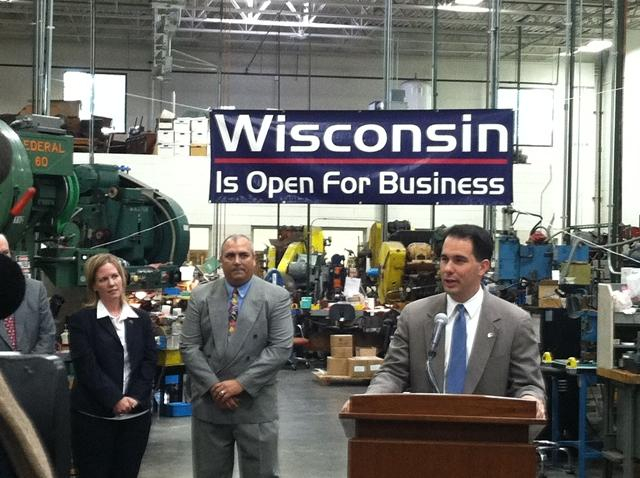Walker Cost State 80,000 Jobs
Jobs grew 33 percent less under him compared to other states, the data shows.
How many jobs should Scott Walker get credit for? The question has divided Walker and his critics since he first took office. While Walker has backed off on his promise to create 250,000 jobs in his first term, he claims credit for the fact that “more people are working than ever before in Wisconsin – over 3 million.”
The consensus among economists who’ve studied the issue is that governors get too much credit for a strong economy and too much blame for a bad one. To isolate the effect of a governor on the economy of a state, one needs a “counter-factual” that says what would have happened absent that governor. Based on historical data, how would the state’s economy have performed?
Other states in the upper Midwest share many of the same challenges as Wisconsin. Could a regression model be built that would use these states’ employment numbers to accurately predict Wisconsin’s in the period before Walker became governor? I’ve created such a model using jobs numbers from the four adjacent states (Minnesota, Illinois, Iowa, and Michigan) and two other Great Lakes states —Indiana and Ohio–with a traditional industrial emphasis.
The next graph compares the actual Wisconsin job numbers (in black) with those predicted by the regression model (in orange) between 1990 and 2010. It is stunning how closely the predictions are to the actual Wisconsin jobs numbers. This relationship remains through governors—and presidents–from both parties, and through periods of recession and recovery. This analysis strongly reinforces the belief that governors have limited effect on state economies.
This is reflected in the model’s statistics. For example, its coefficient of determination is .999, meaning that explains 99.9% of the variation in Wisconsin jobs.
This model offers a way to generate a counter-factual for the period starting in 2011. If the previous relationship between Wisconsin employment and the six other states continued, what would that imply about the number of jobs in Wisconsin? As the next graph shows, starting in 2011, the model over-predicts Wisconsin jobs by between 70,000 and 80,000 jobs — meaning actual jobs fell that about 75,000 short of what they should have based on past state performance relative to other states. (I also graphed the numbers using the difference between the predicted and actual numbers, called the residuals, and came up with a similar jobs gap under Walker.)
An alternative approach is to use the whole 1990-2018 time period but add a “Walker variable” for years starting in 2011 based on the difference between expected and actual jobs growth. The multiple regression model calculated a coefficient for the Walker variable of -.95. In other words, for every month Walker was in office about 950 jobs are subtracted from whatever number is calculated from other states’ jobs. By July 2018, this “Walker loss coefficient” translates into 86,000 fewer jobs.
Like the model from 1990-2010, this model manages to very closely track actual Wisconsin jobs, as the next graph shows. This conclusion is also supported by the statistics (R-square of 99.8%).
The next graph looks at just the years under Walker. With the addition of the Walker loss coefficient of -.95, the model’s prediction closely tracks the actual Wisconsin jobs in the Walker era, as shown below.
The average from both models points to a Walker administration which cost Wisconsin 80,000 jobs. This loss was masked by national job growth. If Wisconsin had followed the same pattern relative to its neighbors as under previous administrations, jobs would have grown by an additional 33 percent — quite a difference. To put the shortfall in perspective, the 80,000-job loss is six times the 13,000 jobs promised from the Foxconn development in Racine.
It is hard to identify possible causes for Wisconsin’s jobs lag other than the administration’s policies. It is not as if the state is dependent on a single industry. Rather, the underlying cause seems to be the triumph of ideology over evidence as to what grows an economy. Here is a partial list of examples.
Even before he took office, Walker rejected federal funds to re-establish rail transportation between Milwaukee and Madison. This seems a mistake on several levels. It broadcast a message that Wisconsin was closed for innovation and that the only serious transportation initiatives would be limited to cars and trucks. More recently, this attitude was reflected in the administration’s hostility to the Milwaukee street car.
Walker, to his credit, found a way to eliminate the gap between Medicaid and insurance policies bought through the Obamacare exchanges. But by turning down federal funds for Medicaid expansion (because of his opposition to Obamacare), Walker cost state taxpayers in the neighborhood of $1 billion, money that would have had a positive impact on the state economy.
The Walker administration’s refusal to recognize global warming, came at a price. Right from the start the administration opposed expanded wind power. This has helped make Wisconsin an expensive state for electricity and probably cost jobs in alternative energy.
In the future, states that prosper are likely to be those that people are attracted to for their quality of life. Thus, the most successful states will increasingly compete on a quality strategy rather than one of low cost, particularly for wealthy people and businesses. As the first state to convert an unused rail right of way to a bike trail, Wisconsin had a lead in the lifestyle competition. Unfortunately, it chose to give up that advantage as reflected in the following explanation from the League of American Bicyclists explaining why it had downgraded Wisconsin for bicycle friendliness:
Wisconsin fell significantly this year. In fact, this year is the first year that Wisconsin has been ranked outside the Top 10. This major drop is primarily due to one thing – Wisconsin’s first-in-the-nation repeal of a Complete Streets law. While over 1000 communities throughout the nation and more than two-thirds of states have been adopting and implementing laws and policies that codify the common sense idea that streets should be designed and maintained for all users – the Wisconsin legislature decided that it was inappropriate to require that streets are designed so that people who bike could do so safely.
It is true that governors are limited as to how much influence they can have on jobs. National and international trends, as well as being in the right place at the right time usually play a much greater role. Even so, a state can pay a price for a series of bad decisions and Wisconsin has.
Unfortunately, many of these decisions will continue to haunt Wisconsin in future years, regardless of the results of the November election.
Data Wonk
-
Life Expectancy in Wisconsin vs. Other States
 Dec 10th, 2025 by Bruce Thompson
Dec 10th, 2025 by Bruce Thompson
-
How Republicans Opened the Door To Redistricting
 Nov 26th, 2025 by Bruce Thompson
Nov 26th, 2025 by Bruce Thompson
-
The Connection Between Life Expectancy, Poverty and Partisanship
 Nov 21st, 2025 by Bruce Thompson
Nov 21st, 2025 by Bruce Thompson
























The data indicates that WI has been sucking hind teat re job creation when compared with neighboring states. Add to that the deterioration of our schools and roads during Walker’s terms and his campaign for re-election should be running on fumes from bad gas. That said, Walker could still win if he and PACS such as ARISTOCRATS FOR PERFIDY succeed at demonizing Evers.
Thanks for adding that “Actual vs predicted” chart for 2010-2018, Bruce. This is really good work, and it shows how far behind we have fallen as the rest of the country, and even the Midwest, has rebounded from the Great Recession.
Notice that Walker never properly gives credit to the real reason our economy is better off since 2010- The Obama Recovery. And given that Walker sold himself as someone who would take our economy to a new level by being “open for business”, it may be even more appropriate to note that we are 136,000 or so jobs behind the US rate of growth since January 2011. Especially since Wisconsin’s low population growth also is at least in part due to Walker’s and WisGOP’s socially regressive policies driving talent out of the state.
http://jakehasablog.blogspot.com/2018/08/strong-july-jobs-report-in-wisconsin.html
I agree with Jake that the ACTUAL vs PREDICTED chart is especially telling. It also reinforces the demonstrable failure of Walker’s promise of 250K new jobs in his first 4 years.
I also second Jake on his observation re “socially regressive policies driving talent out of the state.” Anecdotally, I note here that nearly a dozen grown children of our friends and neighbors have relocated to Minnesota, and I cannot think of one grown child of friends from MN who has relocated to WI. We may need to get Walker out of office to have a chance at getting some of our grown children back home.